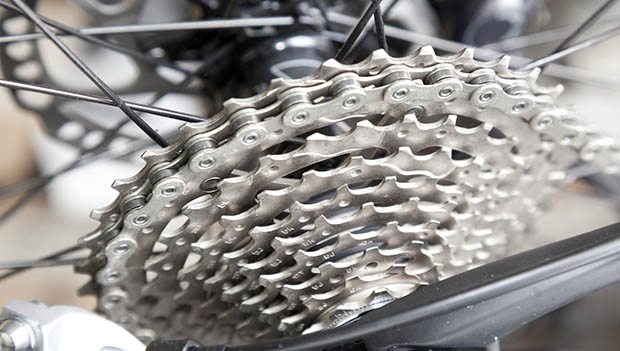
If you’re looking to upgrade your drivetrain or get new parts to replace worn ones, knowing what you can mix and match before you open your wallet or your toolbox can be beneficial.
Overview
You can’t cram more gears on a wheel mounted to a bike with a shifter that accommodates fewer speeds. So if you want to go from 10 speeds to 11 speeds, you need to match the number of gears on your rear wheel with the gearing capacity of your shifters. You should also be aware that if you’re using a rear bike wheel that only accommodates an older 8/9/10 speed cassette, you may run into trouble upgrading your cassette to a newer one that’s meant to accommodate up to 11 speeds.
Cross-Brand
We think it’s a good idea to stick with one brand of bike components, to achieve optimal shifting performance. If you have Shimano shifters, you should run Shimano gears with Shimano chains, and likewise for SRAM, Campagnolo and other brands. But there are a few exceptions: You can mix and match SRAM and Shimano chains and cassettes, and still get decent performance. Brake and shifting cables will also function, cross-brand.
Electronic Shifting
If your bike has electronic shifting, you may only be able to cross brands for an aftermarket chain and cassette. If you have Campagnolo EPS electronic shifting, we strongly recommend sticking with an all-Campy drivetrain for optimal performance.
Shifters
When upgrading gearing capacity—from 10 to 11 speeds, for instance—you’ll need to upgrade the shifters on your bike. If you want a performance bump, you can upgrade from a lower tier group to higher tier group within the same brand (e.g., SRAM Apex to SRAM Red).
Cassettes
Rear cogs (“gears”) come in clusters called cassettes. Just a few years ago, cassettes most commonly had eight or nine cogs. Cycling component manufacturers are now producing cassettes with 12 speeds. However, 11 speeds are still most common. If you want to move from 10 speeds to 11, or from 11 speeds to 12, you’ll need to upgrade the cassette on your rear wheel (and also your shifters).
Chains
An easy rule-of-thumb is you can use a narrower chain than what you currently have. If you have 10 speeds, you can use an 11-speed chain–but narrower chains cost more, and you won’t get any reasonable performance bump.
SRAM chains will work with Shimano gears and vice versa. Where you can improve your bike’s performance and maybe save a few watts of friction is by using a high-quality aftermarket chain meant for the number of gears on your cassette and shifters.
Chainrings
If want to go with a smaller chainring (“front gears”) so you can spin more, and climb more easily, stick with the brand and model of chainring currently on your bike. Chainring bolt patterns—the number of bolts and spacing between the bolts that keeps the chainrings affixed to the crank—are brand-specific.
Derailleurs
The mechanisms that move the chain from one gear to another—derailleurs—function best when they are brand-matched to shifters. When upgrading from 10 to 11 speeds, you may need to upgrade the rear derailleur to one with a long cage if your bike is not already equipped with one. Many 11-speed cassettes have a large gear in excess of 27 teeth. This large gear necessitates a medium-cage or long-cage derailleur that can move a chain to and from a large-diameter cog.
READ THIS NEXT: Simple Bike Maintenance Tips: How to Swap Brake Pads









Discuss This Article